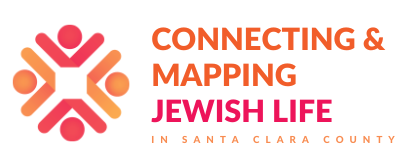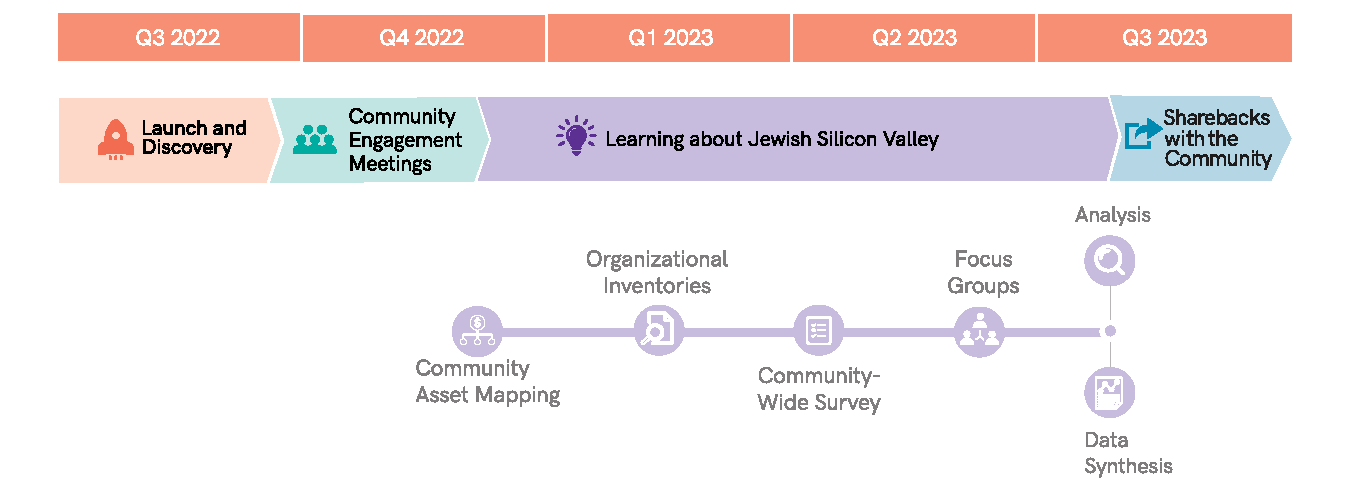
Jewish Community Study
Jewish Silicon Valley is conducting a community-wide study to produce a broader and deeper understanding of the makeup and assets of the Jewish community in Santa Clara County. Through this study, we are hoping to establish a continual learning network that is responsive to changes and growth within the community from this point onwards.
With full financial support from the Chai House Board of Directors, we are launching this study in partnership with Rosov Consulting, a premiere Jewish organizational consulting firm with deep roots in the Bay Area Jewish world, to conduct a multi-faceted, twelve to fifteen month-long study of the Jewish Silicon Valley community. The study began in the fall of 2022 and will conclude in the fall of 2023.
Read our blog post that introduces the study: Connecting and Mapping Jewish Life in Santa Clara County
Purpose
The goal of this study is multi-pronged. In addition to providing a snapshot of community needs, the process of the study itself will forge the beginnings of a continuous learning network, helping all members of the community connect on a broader and deeper level to those around them. In this way, the study will support our journey towards a vibrant Jewish community in Santa Clara County.
Connecting and Mapping Jewish Life in Santa Clara County is designed:
- To uncover and clarify the concerns, needs, preferences, ideas, and suggestions of people who identify as Jewish or are somehow connected to Judaism
- To assess where current physical assets, programs and activities exist spatially within the region
- To understand the spiritual, racial, gender and sexuality, and economic diversity of the Jewish community and increase accessibility based upon various identities
- To provide reliable and relevant data for determining funding priorities for supporting and enhancing Jewish life in Santa Clara County
Previous Studies
This Community Study has been informed by and builds upon previous Bay Area-wide surveys. Feel free to peruse the following to gain a better understanding of the studies that have informed the Connecting and Mapping Jewish Life in Santa Clara County study.
Core Questions
- What are the Jewish needs in the community?
- What do people want from Jewish organizations?
- Where are Jewish communities located?
- How can the Jewish community serve the broader community?
- What does racial and economic diversity look like within the Jewish community?
- How has the pandemic impacted our lives?
- How can we create a continuous Jewish learning network?
- How do you connect to your Jewish identity?
- How do we create a culture of Jewish philanthropy?
- What are families looking for in Jewish education?
Key Focus Areas
Philanthropy
Organizations
Education
Arts and Business
Spiritual and Religious Life
Relationships with Broader Community
Socioeconomics
Race
Language
History
Diversity, Equity, and Inclusion
This study celebrates the economic, racial, and ethnic diversity within our region. We are engaging with Dr. Helen Kim to provide Diversity, Equity, and Inclusion oversight and consultation for all facets of the survey design and implementation. Professor Kim, whose scholarship focuses on race and American Judaism in the contemporary era, has worked with various dimensions of the Jewish Silicon Valley communal ecosystem and is invested in ensuring that our efforts result in a nuanced and deep understanding of the economic, racial, and ethnic landscape in our region.
Project Overview

Q3 2022 | Community Engagement Meetings (*In Progress)
In October 2022, Jewish Silicon Valley convened five stakeholder conversations to engage a sampling of the larger Jewish community to provide input to guide the design of the study. At these meetings, the following four questions were posed for reflection:
- Think about your Jewish community and reflect on challenges that are most apparent.
- Think about your Jewish community and reflect on the opportunities for change.
- What does your ideal Jewish community look like?
- What specific subpopulations are you most interested in seeing from the study?
These questions offer an excellent opportunity for reflection and we encourage you to engage and consider your own responses to these questions. We would love to hear what comes up for you! If you would like to share your responses, please fill out this form.
With the five meetings completed, Rosov Consulting summarized and synthesized the findings and posed some key reflections that the study will be testing and expanding upon. These findings will be used to inform the development of all subsequent aspects of the study.
Findings:
Some of the challenges to the community include:
- Affordability of participation within the Jewish Community, tied with high cost of living in the region resulting in people moving in and out of the region
- Limited physical gathering spaces for people to meet and make new friends
- Lack of cohesion across generations, language, and religiosity
- Mental Health and Social Isolation
Some of the opportunities for the community include:
- People are seeking out connection, meaning, purpose, and community
- Resources and assets are abundant in this region
- There are endless ways of identifying as Jewish
- Technology can help play a critical role in connecting community
Do you agree? Disagree? Can you think of other challenges and opportunities to add?
Q4 2022 | Community Asset Mapping
Using cutting edge ArcGIS software, we will produce an interactive, multi-layered map of Jewish assets and organizations in Santa Clara County. Once completed, this map will offer a tremendous visual representation of the local Jewish organizational infrastructure. The map will include some or all of the following layers:
- Physical locations of Jewish communal organizations in or that serve people in the area.
- Physical locations of other community assets that may be primary partners with the Jewish organizational ecosystem (e.g., early childhood centers; other independent schools; social service organizations; etc.).
- Zip code location and density of Jewish households, in total and by demographic and Jewish characteristics, from the 2018 Bay Area Jewish Community Portrait
We recognize that during the pandemic, many community members gathered to form virtual groups and organizations that cannot be isolated to a single place. We are exploring options of including these organizations and groups in the asset map as well.
Q1 2023 | Organizational Inventories
To dive deeper into the Jewish organizational infrastructure in Santa Clara County, we are inviting Jewish communal organizations to fill out an organization-specific survey that will allow us to share information about up-to-date offerings, programs, and services. Much of this information will provide greater detail to the organizations that are mapped.
Examples of information the inventory might collect include:
- Constituencies served (numbers and characteristics)
- Programs, services, activities, and events
- Organizational calendar
- Physical facilities
- Organizational financial data (e.g., budgets, revenue sources, expenditures) where feasible to collect
Q1 2023 | Community-Wide Surveys
One of the major components of this study is a general population survey. We invite all community members who identify as Jewish, who are connected to people who identify as Jewish, and who are connected to Jewish organizations or the community in some way, to complete the survey. The purpose of this survey is to gain a broad understanding of the diversity of identities, needs, perspectives, and opinions of Jewish people in Santa Clara county. For this reason, it is critical that as many people respond to the survey as possible, to ensure that it adequately reflects the diversity of the Santa Clara County Jewish Community.
The goal of this survey is not only to provide a momentary glimpse of the Jewish community.
If you haven’t yet taken the survey, fill out this form and you will receive a personalized link for the survey. Send this link to your friends! And your family! And to that person you always say hi to at the synagogue or the gym or where you pick up your kids from school!
Surveys can be translated into Spanish, Hebrew, and Russian as needed.
Q2 2023 | Focus Groups
While collecting these surveys provides critical numerical data, a deep dive into the lived experience of community members will bring that information to life. Where surveys are broad and reflect the “who, what, and where,” the focus groups will elucidate the “why and how.”
We will organize between 8-12 focus groups based upon shared characteristics and/or interests, such as members of interfaith families, immigrants, parents of young children, people who identify as culturally Jewish, people who identify as LGBTQ+, or residents of the same neighborhoods, etc. Ideally, focus groups have 4–8 people in them. Focus groups invitations will go out based upon survey respondents, but if you have a group gathered together that would be interested in forming a focus group, please do not hesitate to reach out.
Q3 2023 | Final Report & Sharebacks with the Community
With the completion of the study elements, we will compile and analyze the data collected through mappings, inventories, the survey, and focus groups into a final report. This report will highlight major research findings and learnings while identifying key strategic and actionable opportunities for community investment, action, mobilization, and change.
The final report will be presented at a community forum that is open to the public. Details for this community presentation are forthcoming.






